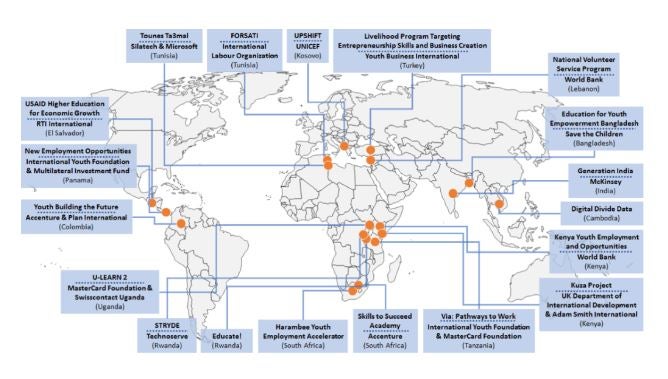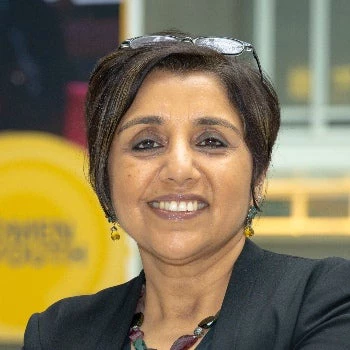
Tomorrow is International Youth Day!
This year, we have reasons to celebrate. Globally, more and more young people are receiving an education and women are making some progress in key indicators like life expectancy and economic engagement outside the home. But there persist urgent reasons to double down on efforts to engage the global youth population in productive work:
-
The global youth unemployment rate is on the rise after several years of improvement. Youth account for roughly 40% of the world’s unemployed, 3x more likely to be unemployed than adults.
-
1 in 4 young people in the world cannot find jobs paying more than $1.25 per day, the international threshold of extreme poverty.
-
Youth are at the heart of migration. Between 2010 and 2015, the estimated net inflow of young people of working age population was 14.8 million.
International Youth Day reminds us of the critical importance of this work, but also of the incredible efforts made by youth employment programs around the world. At Solutions for Youth Employment (S4YE), we support and learn from many of these organizations. The 19 members of our Impact Portfolio serve as a “learning laboratory”, representing fifteen developing countries across six continents, and we keep up with their progress through detailed consultation meetings and regular informal communications. Here are some examples of the innovative efforts they are making:
-
Industry Advisory Boards: Industry Advisory Boards are a model for systematic coordination between universities and industry associations in El Salvador to collaborate on labor market trends, internships and practical training, and updating curricula to meet industry needs. This was adapted from the U.S. community college and industry model and customized to meet the Salvadoran context.
-
Youth entrepreneurs: Educate!, based in Rwanda, helps young entrepreneurs generate business ideas that use local resources and are socially responsible. Examples include briquets made of anthill soil to reduce firewood consumption, school-wide savings and loan cooperatives, and file folders made from braided banana fibers.
-
Access to finance: A number of projects on our Impact Portfolio are taking interesting approaches to increasing access to finance for youth. In Colombia, Youth Building the Future (organized by Accenture and Plan International) is using mobile banking technology to open savings accounts for youth. In Turkey, the Habitat Association and Youth Business International (YBI) are conducting a market analysis to better understand the financial needs of Syrian refugees and tailoring financial instruments accordingly. In Rwanda and Uganda, STRYDE (organized by Technoserve and the Mastercard Foundation) and U-LEARN 2 (organized by MasterCard Foundation & Swisscontact Uganda) are helping facilitate access to youth- and smallholder farmer-friendly products and services.
-
Psycho-social support: A number of projects working with refugee youth or youth living in armed conflict areas are starting to include psycho-social support services. Youth Building the Future in Colombia includes group psycho-social counseling sessions to help youth deal with violence they witness in their communities. Additionally, the National Volunteer Service Program (organized by the World Bank) in Lebanon expanded its soft skills training to include psycho-social awareness to address the mental health and trauma issues experienced by Syrian refugee youth.
-
Economic analysis: Harambee Youth Employment Accelerator measures both economic returns and social returns. Measurements of economic returns are primarily based on calculations of the benefits from the reduction in labor intermediation costs, higher productivity workers, and increased worker retention. Their measurements of social returns are based on a combination of the net increased incomes of beneficiaries and the indirect benefit to other individuals and families that have proximity to beneficiaries. By their calculations, the indirect social benefit estimates are much greater than the net increase in income beneficiaries.

For a full list of Impact Portfolio projects and a brief overview, see here. Stay tuned for a comprehensive report, New and Promising Approaches in Youth Employment Programs: The S4YE Impact Portfolio, which curates these and many other innovations (to be released shortly).
In addition to the Impact Portfolio, S4YE is tacking youth employment issues from a variety of other angles. To this end, S4YE recently updated and refocused its strategic priorities, targeting 1) Innovation and 2) Knowledge, Learning, and Communications. Our core thematic focuses on gender, youth participation, and private sector engagement permeate each of these platforms.
Through our Innovation agenda, we are working at the forefront of youth employment efforts. Currently, we are designing a 2nd generation of innovative youth employment programs: a more integrated framework that will draw on evidence-based practices from the Impact Portfolio to tackle both demand-side constraints (e.g. job creation) and supply-side constraints (e.g. mismatches in skills). We will pilot this approach in a few countries, working closely with the private sector and employing robust evaluations to enable future scale. An aspect of our focus on innovation will be in the area of digital jobs, with a particular focus on young women, utilizing the deep expertise of our partners like Accenture, Microsoft, Rockefeller Foundation, Plan International, and others to harness the potential of the emerging digital economy and make it accessible to young women.
Our Knowledge, Learning, and Communications platform collects what we’ve learned, building a library of resources and sharing it with the broader employment community. And we’ve learned a lot. In addition to the upcoming Impact Portfolio Report, we have a rich portfolio of research, beginning with our Baseline Report, continuing with this year’s annual report on Youth on the Move, and soon to include Skills Gap or Signaling Gap? Insights from LinkedIn in emerging markets of Brazil, India, Indonesia, and South Africa, a paper coauthored by LinkedIn. We’re partnering with other experts to put out shorter briefs on hot button issues for youth employment practitioners; two recent briefs focused on employment services (co-authored by GIZ) and private sector linkages (co-authored by IFC). And finally, we’re strengthening the community through workshops, online discussions, webinars, private sector roundtables, and more, to bring critical actors together for shared learning opportunities. Note: Stay tuned for the upcoming release of our new website, where all of these resources will soon be publicly available.
On International Youth Day and beyond, S4YE is committed to confronting these issue head on, uniting the public sector, private sector, and civil society to find practical and scalable solutions to create new economic opportunities for young people. For more information on our strategy and work streams, check out our strategic overview here.
Follow the World Bank Jobs Group on Twitter @wbg_jobs.



Join the Conversation